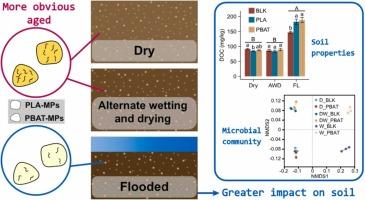Aging of biodegradable microplastics and their effect on soil properties: Control from soil water
IF 12.2
1区 环境科学与生态学
Q1 ENGINEERING, ENVIRONMENTAL
引用次数: 0
Abstract
The ecological risks of biodegradable microplastics (BMPs) to soil ecosystems have received increasing attention. This study investigates the impacts of polylactic acid microplastics (PLA-MPs) and polybutylene adipate terephthalate microplastics (PBAT-MPs) on soil properties of black soil (BS) and fluvo-aquic soil (FS) under three water conditions including dry (Dry), flooded (FL), and alternate wetting and drying (AWD). The results show that BMPs exhibited more evident aging under Dry and AWD conditions compared to FL condition. However, BMPs aging under FL condition induced more substantial changes in soil properties, especially dissolved organic carbon (DOC) concentrations, than under Dry and AWD conditions. BMPs also increased the humification degree of soil dissolved organic matter (DOM), particularly in BS. Metagenomic analysis of PBAT-MPs treatments showed different changes in microbial community structure depending on soil moisture. Under Dry conditions, PBAT-MPs enhance the ammonium-producing process of soil microbial communities. Genes related to N nitrification and benzene degradation were enriched under AWD conditions. In contrast, PBAT-MPs do not change the abundance of genes related to the N cycle under FL conditions but significantly reduce genes related to benzene degradation. This reduction in benzene degradation genes under FL condition might potentially slow down the degradation of PBAT-MPs, and could lead to temporary accumulation of benzene-related intermediates. These findings highlight the complex interactions between BMPs, soil properties, and microbial communities, emphasizing the need for comprehensive evaluations of BMPs’ environmental impacts under varying soil water conditions.

可生物降解微塑料的老化及其对土壤性质的影响:土壤水的控制
可生物降解的微塑料(BMPs)对土壤生态系统造成的生态风险日益受到关注。本研究调查了聚乳酸微塑料(PLA-MPs)和聚己二酸丁二醇酯微塑料(PBAT-MPs)在干燥(Dry)、淹没(FL)和干湿交替(AWD)三种水条件下对黑土(BS)和氟水土(FS)土壤性质的影响。结果表明,与 FL 条件相比,BMP 在干燥和 AWD 条件下表现出更明显的老化。然而,在 FL 条件下老化的 BMP 比在干燥和 AWD 条件下引起的土壤性质变化更大,尤其是溶解有机碳 (DOC) 浓度。BMP 还提高了土壤溶解有机物(DOM)的腐殖化程度,尤其是在 BS 中。对 PBAT-MPs 处理进行的元基因组分析表明,微生物群落结构随土壤湿度的变化而变化。在干燥条件下,PBAT-MPs 能增强土壤微生物群落的产铵过程。在 AWD 条件下,与氮硝化和苯降解相关的基因被富集。相反,在 FL 条件下,PBAT-MPs 不会改变氮循环相关基因的丰度,但会显著降低苯降解相关基因的丰度。在 FL 条件下,苯降解基因的减少可能会减缓 PBAT-MPs 的降解速度,并可能导致苯相关中间产物的暂时积累。这些发现凸显了 BMP、土壤性质和微生物群落之间复杂的相互作用,强调了在不同土壤水条件下全面评估 BMP 对环境影响的必要性。
本文章由计算机程序翻译,如有差异,请以英文原文为准。
求助全文
约1分钟内获得全文
求助全文
来源期刊

Journal of Hazardous Materials
工程技术-工程:环境
CiteScore
25.40
自引率
5.90%
发文量
3059
审稿时长
58 days
期刊介绍:
The Journal of Hazardous Materials serves as a global platform for promoting cutting-edge research in the field of Environmental Science and Engineering. Our publication features a wide range of articles, including full-length research papers, review articles, and perspectives, with the aim of enhancing our understanding of the dangers and risks associated with various materials concerning public health and the environment. It is important to note that the term "environmental contaminants" refers specifically to substances that pose hazardous effects through contamination, while excluding those that do not have such impacts on the environment or human health. Moreover, we emphasize the distinction between wastes and hazardous materials in order to provide further clarity on the scope of the journal. We have a keen interest in exploring specific compounds and microbial agents that have adverse effects on the environment.
 求助内容:
求助内容: 应助结果提醒方式:
应助结果提醒方式:


